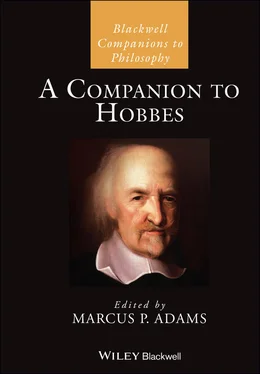Edited by Yitzhak Melamed
76. A Companion to Hobbes
Edited by Marcus P. Adams
Edited by
Marcus P. Adams

This edition first published 2021
© 2021 John Wiley & Sons, Inc.
All rights reserved. No part of this publication may be reproduced, stored in a retrieval system, or transmitted, in any form or by any means, electronic, mechanical, photocopying, recording or otherwise, except as permitted by law. Advice on how to obtain permission to reuse material from this title is available at http://www.wiley.com/go/permissions.
The right of Marcus P. Adams to be identified as the author of the editorial material in this work has been asserted in accordance with law.
Registered Office
John Wiley & Sons, Inc., 111 River Street, Hoboken, NJ 07030, USA
Editorial Office
111 River Street, Hoboken, NJ 07030, USA
For details of our global editorial offices, customer services, and more information about Wiley products visit us at www.wiley.com.
Wiley also publishes its books in a variety of electronic formats and by print-on-demand. Some content that appears in standard print versions of this book may not be available in other formats.
Limit of Liability/Disclaimer of Warranty
The contents of this work are intended to further general scientific research, understanding, and discussion only and are not intended and should not be relied upon as recommending or promoting scientific method, diagnosis, or treatment by physicians for any particular patient. In view of ongoing research, equipment modifications, changes in governmental regulations, and the constant flow of information relating to the use of medicines, equipment, and devices, the reader is urged to review and evaluate the information provided in the package insert or instructions for each medicine, equipment, or device for, among other things, any changes in the instructions or indication of usage and for added warnings and precautions. While the publisher and authors have used their best efforts in preparing this work, they make no representations or warranties with respect to the accuracy or completeness of the contents of this work and specifically disclaim all warranties, including without limitation any implied warranties of merchantability or fitness for a particular purpose. No warranty may be created or extended by sales representatives, written sales materials or promotional statements for this work. The fact that an organization, website, or product is referred to in this work as a citation and/or potential source of further information does not mean that the publisher and authors endorse the information or services the organization, website, or product may provide or recommendations it may make. This work is sold with the understanding that the publisher is not engaged in rendering professional services. The advice and strategies contained herein may not be suitable for your situation. You should consult with a specialist where appropriate. Further, readers should be aware that websites listed in this work may have changed or disappeared between when this work was written and when it is read. Neither the publisher nor authors shall be liable for any loss of profit or any other commercial damages, including but not limited to special, incidental, consequential, or other damages.
Library of Congress Cataloging-in-Publication DataA catalogue record for this book is available from the Library of Congress
Hardback ISBN: 9781119634997; ePDF ISBN: 9781119634980; epub ISBN: 9781119635031; oBook ISBN: 9781119635079.
Cover image: © Thomas Hobbes, artist John Michael Wright, National Portrait Gallery, public domain, Wikimedia Commons
Cover design by Wiley
Set in 10/12.5pt Photina by Integra Software Services, Pondicherry, India
1 Cover
2 Blackwell Companions to Philosophy
3 Title Page
4 Copyright
5 Notes on Contributors
6 Introduction: The Presentation and Structure of Thomas Hobbes’s Philosophy
7 Abbreviations for Citations to Hobbes’s Works
8 Part I: First Philosophy, Mathematics, and Natural Philosophy Chapter 1: Hobbes’s Unified Method for Scientia Chapter 2: The Stoic Roots of Hobbes’s Natural Philosophy and First Philosophy Chapter 3: Hobbesian Mathematics and the Dispute with Wallis Chapter 4: Explanations in Hobbes’s Optics and Natural Philosophy
9 Part II: Human Nature and Morality Chapter 5: “A Most Useful Economy”: Hobbes on Linguistic Meaning and Understanding Chapter 6: Hobbes’s Theory of the Good: Felicity by Anticipatory Pleasure Chapter 7: In search of “A Constant Civill Amity”: Hobbes on Friendship and Sociability Chapter 8: Hobbes on Power and Gender Relations Chapter 9: The State of Nature as a Continuum Concept Chapter 10: Hobbes’s Minimalist Moral Theory
10 Part III: Civil Philosophy Chapter 11: Hobbesian Persons and Representation Chapter 12: Hobbes’s Account of Authorizing a Sovereign Chapter 13: The Strength and Significance of Subjects’ Rights in Leviathan Chapter 14: Hobbes on Sovereignty and Its Strains Chapter 15: Hobbes on International Ethics
11 Part IV: Religion Chapter 16: Against Philosophical Darkness: A Political Conception of Enlightenment Chapter 17: Hobbes on Submission to God Chapter 18: Thomas Hobbes and the Christian Commonwealth Chapter 19: Hobbes and Toleration Chapter 20: Hobbes, Rome’s Enemy Chapter 21: Hobbes and the Papal Monarchy
12 Part V: Controversies and Reception Chapter 22: Body and Space in Hobbes and Descartes Chapter 23: Hobbes’s Mechanical Philosophy and Its English Critics Chapter 24: Cudworth as a Critic of Hobbes Chapter 25: Cavendish and Hobbes on Causation Chapter 26: Striving, Happiness, and the Good: Spinoza as Follower and Critic of Hobbes Chapter 27: Hobbes and Astell on War and Peace Chapter 28: Hobbes and Hume on Human Nature: “Much of a Dispute of Words?” Chapter 29: He Shows “Genius” and Is “More Useful than Pufendorf”: Kant’s Reception of Hobbes Chapter 30: Catharine Macaulay and the Reception of Hobbes During the Eighteenth Century
13 Index
14 End User License Agreement
1 Chapter 0Figure I.1 The order of presentation in Hobbes’s Philosophy: The Table of Leviathan 9 compared to the Elements of Philosophy trilogy.
2 Chapter 3Figure 3.1 Cavalieri’s indivisibles.
3 Chapter 4Figure 4.1 Hierarchy of the parts of philosophy.Figure 4.2 Orders of knowing to arrive at civil philosophy.Figure 4.3 Diagram from De homine II.
4 Chapter 9Figure 9.1 Continuum of permissible private judgment.Figure 9.2 Scope for effective personal agency mapped onto the continuum of permissible private judgment.
5 Chapter 12Figure 12.1 The one-step third-party beneficiary account.Figure 12.2 The two-step account.
1 Cover
2 Blackwell Companions to Philosophy
3 Title Page
4 Copyright
5 Table of Contents
6 Notes on Contributors
7 Begin Reading
8 Index
9 End User License Agreement
1 i
2 ii
3 iii
4 iv
5 v
6 vi
7 vii
8 viii
9 ix
10 x
11 xi
12 xii
13 xiii
14 1
15 2
16 3
17 4
18 5
19 6
20 7
21 8
22 9
23 10
24 11
25 12
26 13
27 14
28 15
29 16
Читать дальше













